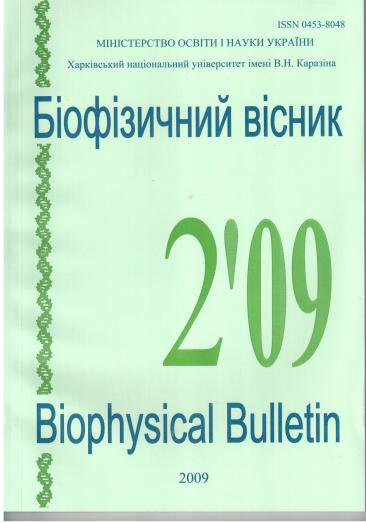Peculiarities of the prime structures of the red fluorescent proteins that change their fluorescent spectra with time
Abstract
By the directed sight-specific and accidental mutagenesis of the red fluorescent protein mCherry, 3 mutant
proteins have been developed, named fluorescent timers (FT), which, in contrast to initial protein, change their fluorescence from blue to red. Their prime structures have been determined. Isolated mutant proteins differ one from another by the rate of the fluorescence spectra changes with the different rate: fast (FFT), Medium (MFT), and Slow (SFT). In comparison with initial mCherry FFT contains 5 amino acid replacements.
Lys→Arg, Leu→Trp, Ala→Ser at 69, 84 & 224 positions are internal, and Glu→Lys, Ser→Thr at 34 and 15
positions are situated at the external surface of the protein. In the amino acid sequence of MFT, there have been found 9 substitutions. Replacements Lys→Arg, Leu→Trp, Met→Ile, Leu→Met at 69, 84, 152 & 205 positions are internal, Asn→Asp, Thr→Ser, Gln→Lys, Tyr→Cys, Arg→His at 23, 43, 194, 221 & 227- external. SFT has only 4 replacements. Three of them Lys→Arg, Leu→Trp, Ala→Val at 69, 84 & 179 positions are in the
inner space of the molecule, Glu→Val at 30 positions is at its surface. The structural roles of substitutions that have been found are discussed in relation to the fluorescent properties of FFT, MFT, and SFT and their difference from the properties of mCherry and one from another.
Downloads
References
2. Miyawaki A., Karasawa S. Memorizing spatiotemporal patterns // Nat. Chem. Biol. – 2007. – V. 3. – P. 598-601.
3. Terskikh A. "Fluorescent timer": protein that changes color with time // Science. – 2000. – V. 290. – P. 1585-1588.
4. Mirabella R., Franken C., van der Krogt G.N., Bisseling T., Geurts R. Use of the fluorescent timer DsRed-E5 as reporter to monitor dynamics of gene activity in plants // Plant Physiol. –2004. – V. 135. –P. 1879-1887.
5. Verkhusha V.V., Chudakov D.M., Gurskaya N.G., Lukyanov S., Lukyanov K.A. Common pathway for the red chromophore formation in fluorescent proteins and chromoproteins // Chem. Biol. – 2004.– V. 11. – P. 845-854.
6. Subach F.V., Subach O.M., Gundorov I.S., Morozova K.S., Piatkevich K.D., Cuervo A.M., Verkhusha V.V. Monomeric fluorescent timers that change the color from blue to red // Nat. Chem. Biol. – 2009. – V. 5:2. – P. 118-126.
7. Субач Ф.В., Морозова Е.С., Верхуша В.В., Перский Е.Э. Спектральные характеристики красных флуоресцентных белков, изменяющих спектр флуоресценции во времени // Біофізичний Вісник – 2009. – №. 22 (1) – C. 116-122.
8. Ho S.N., Hunt H.D., Horton R.M., Pullen J.K., Pease L.R. Site-directed mutagenesis by overlap extension using the polymerase chain reaction // Gene –1989. – V. 77. –P. 51-59.
9. Shu X., Shaner N.C., Yarbrough C.A., Tsien R.Y., Remington S.J. Novel chromophores and buried charges control color in mFruits // Biochemistry –2006. – V. 45. – P. 9639- 9647.
10. Bevis B.J., Glick B.S. Rapidly maturing variants of the Discosoma red fluorescent protein (DsRed) // Nat. Biotechnol. –2002. – V. 20. –P. 83-87.
11. Remington S.J. Fluorescent proteins: maturation, photochemistry and photophysics // Curr Opin Struct Biol. – 2006. – V. 16. –P. 714-721.
12. Reid B.G., Flynn G.C. Chromophore formation in green fluorescent protein // Biochemistry – 1997. – V. 36. – P. 6786-6791.
13. Yarbrough D., Wachter R.M., Kallio K., Matz M.V., Remington S.J. Refined crystal structure of DsRed, a red fluorescent protein from coral, at 2.0-A resolution // Proc Natl Acad Sci U S A – 2001. – V. 98. – P. 462-467.
Authors who publish with this journal agree to the following terms:
- Authors retain copyright and grant the journal right of first publication with the work simultaneously licensed under a Creative Commons Attribution License that allows others to share the work with an acknowledgement of the work's authorship and initial publication in this journal.
- Authors are able to enter into separate, additional contractual arrangements for the non-exclusive distribution of the journal's published version of the work (e.g., post it to an institutional repository or publish it in a book), with an acknowledgement of its initial publication in this journal.
- Authors are permitted and encouraged to post their work online (e.g., in institutional repositories or on their website) prior to and during the submission process, as it can lead to productive exchanges, as well as earlier and greater citation of published work (See The Effect of Open Access).





